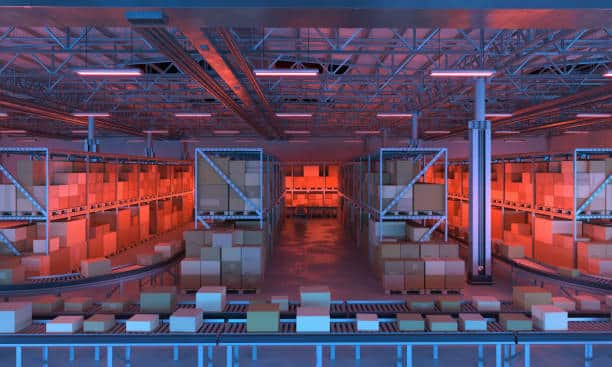A warehouse refers to a large building or facility where goods or products are stored and managed. Warehousing is an essential part of the logistics and supply chain management processes, where it ensures the safekeeping of goods until they are ready for distribution or sale. Warehousing involves the receipt, storage, and dispatch of goods and various activities such as packing, sorting, labeling, and inventory management.
Types of Warehousing
The following are the different types of warehousing:
#1. Private
This is a facility that is owned and operated by a company to store its own products. These warehouses are used for long-term storage and distribution of products and are usually located near the company’s manufacturing unit.
#2. Public
Public warehousing provides storage and other related services to multiple companies. These warehouses are usually operated by third-party logistics providers and offer shared storage space to different businesses.
#3. Bonded
Goods are stored in a bonded warehouse without paying import duties or taxes until they are ready for distribution. These warehouses are used for the temporary storage of goods before they are exported or sold in the local market.
#4. Automated
The storage and movement of goods are managed by automated systems such as conveyor belts and computerized systems. These warehouses are used to optimize the storage and handling of goods and improve efficiency.
Cold Storage Warehouse: In this facility, goods that require temperature-controlled storage, such as perishable goods and pharmaceuticals, are stored. These warehouses have refrigeration systems to maintain the required temperature and humidity levels.
Functions of a Warehouse
The function of warehousing is to provide a safe and secure place to store goods until they are needed for sale or distribution. Warehousing serves several important functions in the supply chain management process, including:
- Storage: Warehouses provide a place to store goods until they are ready for distribution or sale. This helps to ensure that goods are available when customers need them and helps to prevent shortages or stockouts.
- Inventory Management: Warehouses help manage inventory levels by providing a centralized location for tracking and monitoring stock levels. This helps businesses maintain optimal inventory levels and avoid overstocking or understocking.
- Order Consolidation: Warehouses allow businesses to consolidate orders from multiple suppliers or manufacturers into a single shipment. This can help reduce transportation costs and improve efficiency in the supply chain.
- Transportation: Warehouses are often located near transportation hubs such as ports, airports, or rail terminals, making it easier to move goods from the warehouse to their final destination.
- Value-Added Services: Warehouses can also provide value-added services such as packaging, labeling, and quality control inspections. This can help to improve the quality of goods and make them more attractive to customers.
What are Five Functions of a Warehouse?
- Storage
- Inventory management
- Order fulfillment
- Transportation and logistics
- Value-added services
The 3 Basic Functions of Warehousing?
The three basic functions of warehousing are:
#1. Storage:
The primary function of a warehouse is to store goods and products until someone needs them. This includes both short-term and long-term storage of goods. Designers create warehouses to accommodate different types of products and their storage requirements, such as temperature-controlled storage for perishable goods
#2. Handling:
Warehouses are also responsible for handling goods and products. This includes receiving, inspecting, and organizing the products upon arrival. Picking, packing, and shipping them out when required. Handling also includes maintaining inventory accuracy and ensuring efficient storage and retrieval of products.
#3. Transportation:
Warehouses also serve as a hub for transportation, as they are often located in areas that are easily accessible to transportation networks. This allows for easy and efficient movement of goods in and out of the warehouse. Additionally, some warehouses provide transportation services to move goods from the warehouse to their final destination.
Examples of Warehousing
Here are some examples of warehousing:
- Distribution Centers: These are large warehouses for storing goods and sorting them for distribution to retailers or directly to customers.
- Cold Storage Warehouses: Specially designed warehouses for storing perishable goods such as fresh produce, frozen foods, and pharmaceuticals
- Cross-Docking Facilities: Facilities designed to move goods directly from incoming trucks to outbound trucks without storage
- E-commerce Fulfillment Centers: These are warehouses that process online orders and package and ship goods directly to customers.
- Public Warehouses: These are facilities that offer storage space to multiple customers for a fee.
- Manufacturing Warehouses: Manufacturing operations use these facilities to store raw materials, work-in-progress, and finished goods.
What You Should Know about Warehousing
- Warehouse management involves various activities such as receiving and dispatching goods, inventory management, quality control, and order picking.
- Proper warehousing practices are essential to ensure the safekeeping of goods and prevent damage or loss during storage and transportation.
- The location of the warehouse is critical, and it should be easily accessible and close to transportation routes.
- Warehousing costs include rent, labor, insurance, and maintenance, among others.
- To improve the efficiency of warehousing operations, people are using advanced technologies such as automation, robotics, and artificial intelligence.
- Warehousing is a critical component of the supply chain management process that involves the safekeeping and management of goods.
The Principles of Warehousing
There are several principles of warehousing that help ensure efficient and effective operations. These principles include:
#1. Space utilization:
Efficient use of space is crucial in warehousing to minimize costs and maximize storage capacity. This includes optimizing the use of vertical space, implementing racking systems, and using automated storage and retrieval systems.
#2. Organization:
Proper organization of products within the warehouse is essential for effective inventory management and order fulfillment. This involves the use of labeling, signage, and product placement strategies to ensure that products can be easily located and retrieved.
#3. Safety:
Safety is a top priority in warehousing to prevent accidents and injuries. This involves implementing safety protocols and procedures, providing safety equipment, and training all employees in safety practices.
#4. Security:
Warehousing involves the storage of valuable goods, so security is important to prevent theft, damage, or loss. This includes implementing security measures such as cameras, access controls, and alarm systems.
#5. Efficiency:
One should design warehousing operations to optimize efficiency and productivity. This involves streamlining processes, minimizing waste, and using technology to automate tasks where possible.
#6. Flexibility:
One should design warehousing operations to be flexible and adaptable to changing business needs. This includes the ability to scale up or down as needed, and accommodate changes in product mix or order volume.
Important Factors in Warehousing
There are several factors that are important in warehousing, including:
#1. Location:
The location of the warehouse is an important factor as it affects transportation and logistics costs. It is important for the warehouse to be easily accessible by transportation modes such as highways, railroads, and airports.
#2. Size:
It is necessary for the size of the warehouse to correspond with the volume of goods being stored. It should have enough space to accommodate the inventory and the necessary equipment for handling the goods.
#3. Layout:
The warehouse designer should develop a layout that maximizes space usage and improves the efficiency of material handling.
#4. Security:
To prevent theft and illegal entry, builders should construct warehouses with security measures such as alarms, security cameras, and access control systems.
#5. Climate control:
Temperature and humidity control is important for the storage of certain goods, like perishable products, chemicals, and pharmaceuticals.
#6. Inventory management:
A well-designed inventory management system is essential for efficient warehousing. This includes proper labeling, tracking, and management of inventory levels.
#7. Technology:
Technology such as warehouse management systems, barcode scanning, and automation can improve the efficiency and accuracy of warehouse operations.
#8. Workforce:
Properly train the warehouse workforce in handling and storing goods, as well as in the operation of any necessary equipment.
#9. Safety:
Safety protocols and training should be in place to prevent accidents and injuries, especially when operating heavy equipment and handling hazardous materials.
#10. Environmental considerations:
Design warehouses with consideration for the environment, including waste management and energy efficiency.
What is the Benefit of a Warehouse?
Some of the benefits of using a warehouse include:
- Increased storage capacity: Warehouses provide businesses with additional storage space, allowing them to store more inventory and raw materials.
- Improved inventory management: Warehouses help businesses manage their inventory levels better by tracking stock levels and ensuring they store items in a way that maximizes efficiency.
- Faster order fulfillment: By having a centralized location for storing goods, warehouses can facilitate faster and more efficient order fulfillment, reducing lead times and improving customer satisfaction.
- Better supply chain management: Warehouses can also play a key role in managing a business’s supply chain by providing a central hub for receiving, storing, and distributing goods.
- Reduced transportation costs: By consolidating goods in a warehouse, businesses can reduce transportation costs by using larger, more efficient transportation methods.
- Improved product quality: warehouses can provide a controlled environment for storing goods, protecting them from damage, theft, and other risks.
- Flexibility: A business can adapt warehouses to meet its changing needs by changing the layout of the storage space or adding new equipment.
What is the Process of Warehousing?
The process of warehousing involves the receipt, storage, and handling of goods in a designated space or facility, known as a warehouse. This process typically includes the following steps:
Step1. Receiving goods: The recipients receive goods from suppliers, manufacturers, or transporters and check them to ensure that they meet the specified criteria and are in good condition.
Step2. Recording inventory: The warehouse management system (WMS) logs the goods to track their location and quantity.
Step3. Storage: Warehouse personnel place the goods in designated storage locations within the warehouse, often based on factors such as size, weight, fragility, and the required level of accessibility
Step4. Retrieval: When fulfilling an order, the staff retrieves goods from storage based on the order requirements.
Step5. Packing: The staff prepares the goods for shipment, often by packaging them into boxes or pallets.
Step6. Shipping: The company ships the packed goods to their destination, either directly to the end customer or to a distribution center or retailer.
Step7. Inventory management: The staff monitors and manages the inventory levels to ensure that there’s always sufficient stock on hand to meet demand.
Step8. Maintenance: To ensure cleanliness, safety, security, and proper functioning of equipment, the staff maintains the warehouse facility.
Effective warehousing is essential for businesses that rely on efficient inventory management and order fulfillment to meet customer demand. Sophisticated warehouse management software often supports the process by automating many of the steps involved, improving accuracy, and reducing errors.
Read INVENTORY WAREHOUSE MANAGEMENT SOFTWARE: Top 10 Picks
Warehousing Rental
Warehousing rental refers to the practice of renting out a warehouse or storage facility to a company or individual for the purpose of storing goods, merchandise, or other items. It can be beneficial for businesses that need extra storage space but do not want to invest in purchasing a warehouse or for individuals who require a temporary storage solution.
Typically, warehouse rental agreements involve the payment of rent in exchange for the use of the storage space. The agreement’s terms may specify details such as the rental duration, the rented space amount, and any additional services that the provider may offer (such as loading and unloading assistance, security, or climate control).
When considering a warehouse rental, it is important to carefully evaluate the location, size, and amenities of the facility to ensure that it meets your specific storage needs. Additionally, it may be beneficial to negotiate the terms of the rental agreement to ensure that you are getting a fair price and the services you require.
Jobs in Warehousing
There are a variety of jobs available in warehousing, ranging from entry-level positions to management roles. Some common jobs in warehousing include the following:
#1. Warehouse Associate:
This is an entry-level position that involves tasks such as receiving and shipping goods, picking and packing orders, and operating equipment such as forklifts.
#2. Inventory Control Specialist:
In this role, you will track inventory levels and ensure that you properly label and store products in the correct locations.
#3. Warehouse Supervisor:
The day-to-day operations of the warehouse are overseen by a warehouse supervisor, who manages staff, schedules shipments, and ensures that all safety and quality standards are met.
#4. Logistics Coordinator:
This role involves coordinating the movement of goods between the warehouse and other locations, such as suppliers, manufacturers, or customers.
#5. Quality Control Inspector:
A quality control inspector ensures that products meet the required standards for safety and quality and may conduct inspections on incoming and outgoing goods.
#6. Operations Manager:
An operations manager oversees all aspects of the warehouse operation, including managing staff, setting operational goals, and developing and implementing policies and procedures.
#7. Maintenance Technician:
A maintenance technician is responsible for maintaining and repairing the equipment used in the warehouse, such as forklifts, conveyors, and packaging machines.
These are just a few examples of the many jobs available in warehousing. The specific job requirements and qualifications will vary depending on the position and the employer.






